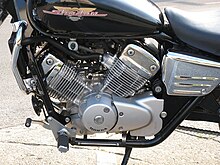A V-twin engine is a type of two-cylinder piston engine where the cylinders are arranged in a “V” shape around the crankshaft. This configuration is commonly used in motorcycles, offering various advantages such as compact size, good primary and secondary balance, and a pleasing firing order. V-twins can have different Vee-angles, with a 90° angle providing optimal balance. Manufacturers like Ducati and Moto Guzzi use this angle in their engines[1].
V-twin engines can be mounted either longitudinally or transversely, each presenting unique challenges such as cooling the rear cylinder or positioning components like the airbox and exhaust pipes. These engines are known for their distinctive firing intervals and can be found in various motorcycles, including Harley-Davidson models like the Evolution and Milwaukee-Eight engines[3].
In contrast to V-twins, straight-twin engines have their two cylinders arranged in a line along a common crankshaft. Also used in motorcycles, these engines come in different configurations like 360°, 180°, and 270° crankshafts. Straight-twins are known for their simplicity and are used in various applications beyond motorcycles, such as automobiles, marine vessels, and ultralight aircraft[2].
Moto Guzzi is a brand famous for its 90° V-twin engine design created by Giulio Cesare Carcano. This air-cooled engine with a longitudinal crankshaft orientation has become iconic for Moto Guzzi motorcycles. The company’s V-twin engines are known for their distinctive transverse cylinder arrangement and shaft drive system, providing the brand with a unique identity in the motorcycle industry[4].
Citations:
https://en.wikipedia.org/wiki/V-twin_engine
[glossary_wikipedia]A V-twin engine, also called a V2 engine, is a two-cylinder piston engine where the cylinders are arranged in a V configuration and share a common crankshaft.

The V-twin is widely associated with motorcycles, primarily installed longitudinally, though also transversely. They are also used in a variety of other land, air, and marine vehicles, as well as industrial applications. The V-twin design dates back to the late 1880s.